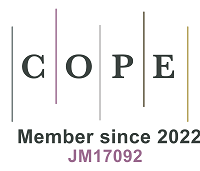REFERENCES
1. Cruz, R.; Cunha, S. C.; Casal, S. Brominated flame retardants and seafood safety: a review. Environ. Int. 2015, 77, 116-31.
2. Sun, C. S.; Yuan, S. W.; Hou, R.; et al. First insights into the bioaccumulation, biotransformation and trophic transfer of typical tetrabromobisphenol A (TBBPA) analogues along a simulated aquatic food chain. J. Hazard. Mater. 2024, 465, 133390.
3. Hou, R.; Lin, L.; Li, H.; et al. Occurrence, bioaccumulation, fate, and risk assessment of novel brominated flame retardants (NBFRs) in aquatic environments - a critical review. Water. Res. 2021, 198, 117168.
4. Alaee, M.; Arias, P.; Sjödin, A.; Bergman, A. An overview of commercially used brominated flame retardants, their applications, their use patterns in different countries/regions and possible modes of release. Environ. Int. 2003, 29, 683-9.
5. Law, R. J.; Allchin, C. R.; de, B. J.; et al. Levels and trends of brominated flame retardants in the European environment. Chemosphere 2006, 64, 187-208.
6. Yu, G.; Bu, Q.; Cao, Z.; et al. Brominated flame retardants (BFRs): a review on environmental contamination in China. Chemosphere 2016, 150, 479-90.
7. Xu, X.; Zhang, Y.; Huang, H.; Chen, J.; Shi, T. Distribution, transformation, and toxic effects of the flame retardant tetrabromobisphenol S and its derivatives in the environment: a review. Sci. Total. Environ. 2024, 948, 174799.
8. Covaci, A.; Voorspoels, S.; Abdallah, M. A.; Geens, T.; Harrad, S.; Law, R. J. Analytical and environmental aspects of the flame retardant tetrabromobisphenol-A and its derivatives. J. Chromatogr. A. 2009, 1216, 346-63.
9. Altwaiq, A. M.; Wolf, M.; van, E. R. Extraction of brominated flame retardants from polymeric waste material using different solvents and supercritical carbon dioxide. Anal. Chim. Acta. 2003, 491, 111-23.
10. de la Torre, A.; Barbas, B.; Sanz, P.; Navarro, I.; Artíñano, B.; Martínez, M. A. Traditional and novel halogenated flame retardants in urban ambient air: gas-particle partitioning, size distribution and health implications. Sci. Total. Environ. 2018, 630, 154-63.
11. Liu, L. Y.; Salamova, A.; Venier, M.; Hites, R. A. Trends in the levels of halogenated flame retardants in the Great Lakes atmosphere over the period 2005-2013. Environ. Int. 2016, 92-3, 442-9.
12. Ali, N.; Harrad, S.; Goosey, E.; Neels, H.; Covaci, A. “Novel” brominated flame retardants in Belgian and UK indoor dust: implications for human exposure. Chemosphere 2011, 83, 1360-5.
13. Cristale, J.; Hurtado, A.; Gómez-Canela, C.; Lacorte, S. Occurrence and sources of brominated and organophosphorus flame retardants in dust from different indoor environments in Barcelona, Spain. Environ. Res. 2016, 149, 66-76.
14. Ricklund, N.; Kierkegaard, A.; McLachlan, M. S. An international survey of decabromodiphenyl ethane (deBDethane) and decabromodiphenyl ether (decaBDE) in sewage sludge samples. Chemosphere 2008, 73, 1799-804.
15. Venkatesan, A. K.; Halden, R. U. Brominated flame retardants in U.S. biosolids from the EPA national sewage sludge survey and chemical persistence in outdoor soil mesocosms. Water. Res. 2014, 55, 133-42.
16. Meironyté, D.; Norén, K.; Bergman, A. Analysis of polybrominated diphenyl ethers in Swedish human milk. A time-related trend study, 1972-1997. J. Toxicol. Environ. Health. A. 1999, 58, 329-41.
17. Covaci, A.; Harrad, S.; Abdallah, M. A.; et al. Novel brominated flame retardants: a review of their analysis, environmental fate and behaviour. Environ. Int. 2011, 37, 532-56.
18. Darnerud, P. O.; Eriksen, G. S.; Jóhannesson, T.; Larsen, P. B.; Viluksela, M. Polybrominated diphenyl ethers: occurrence, dietary exposure, and toxicology. Environ. Health. Perspect. 2001, 109 Suppl 1, 49-68.
19. Law, K.; Halldorson, T.; Danell, R.; et al. Bioaccumulation and trophic transfer of some brominated flame retardants in a Lake Winnipeg (Canada) food web. Environ. Toxicol. Chem. 2006, 25, 2177-86.
20. Sjödin, A.; Patterson, D. G. J.; Bergman, A. A review on human exposure to brominated flame retardants - particularly polybrominated diphenyl ethers. Environ. Int. 2003, 29, 829-39.
21. Ding, Y.; Dong, X.; Feng, W.; et al. Tetrabromobisphenol S alters the circadian rhythm network in the early life stages of zebrafish. Sci. Total. Environ. 2022, 806, 150543.
22. Liu, W.; Pan, Y.; Yang, L.; et al. Developmental toxicity of TCBPA on the nervous and cardiovascular systems of zebrafish (Danio rerio): a combination of transcriptomic and metabolomics. J. Environ. Sci. 2023, 127, 197-209.
23. Jia, X.; Yan, R.; Lin, H.; et al. TBBPA and its alternative TCBPA induced ROS-dependent mitochondria-mediated apoptosis in the liver of Rana nigromaculata. Environ. Pollut. 2022, 297, 118791.
24. Kitamura, S.; Kato, T.; Iida, M.; et al. Anti-thyroid hormonal activity of tetrabromobisphenol A, a flame retardant, and related compounds: affinity to the mammalian thyroid hormone receptor, and effect on tadpole metamorphosis. Life. Sci. 2005, 76, 1589-601.
25. Ren, X. M.; Yao, L.; Xue, Q.; et al. Binding and activity of tetrabromobisphenol A mono-ether structural analogs to thyroid hormone transport proteins and receptors. Environ. Health. Perspect. 2020, 128, 107008.
26. Roh, J. Y.; Lee, H. J.; Kwon, J. H. Internal concentration and time are important modifiers of toxicity: the case of chlorpyrifos on caenorhabditis elegans. Environ. Sci. Technol. 2016, 50, 9689-96.
27. Fu, J.; Fu, K.; Chen, Y.; et al. Long-range transport, trophic transfer, and ecological risks of organophosphate esters in remote areas. Environ. Sci. Technol. 2021, 55, 10192-209.
28. Zhang, X.; Xiong, W.; Wu, Q.; et al. Bioaccumulation, trophic transfer, and biotransformation of polychlorinated diphenyl ethers in a simulated aquatic food chain. Environ. Sci. Technol. 2023, 57, 5751-60.
29. van der Oost, R.; Beyer, J.; Vermeulen, N. P. Fish bioaccumulation and biomarkers in environmental risk assessment: a review. Environ. Toxicol. Pharmacol. 2003, 13, 57-149.
30. Gobas, F. A.; Muir, D. C.; Mackay, D. Dynamics of dietary bioaccumulation and faecal elimination of hydrophobic organic chemicals in fish. Chemosphere 1988, 17, 943-62.
31. Bruggeman, W. A.; Opperhuizen, A.; Wijbenga, A.; Hutzinger, O. Bioaccumulation of super‐lipophilic chemicals in fish. Toxicol. Environ. Chem. 1984, 7, 173-89.
32. Hakk, H.; Letcher, R. J. Metabolism in the toxicokinetics and fate of brominated flame retardants - a review. Environ. Int. 2003, 29, 801-28.
33. Li, H.; Zhang, Z.; Sun, Y.; et al. Tetrabromobisphenol A and hexabromocyclododecanes in sediments and biota from two typical mangrove wetlands of South China: distribution, bioaccumulation and biomagnification. Sci. Total. Environ. 2021, 750, 141695.
34. Morris, S.; Allchin, C. R.; Zegers, B. N.; et al. Distribution and fate of HBCD and TBBPA brominated flame retardants in North Sea estuaries and aquatic food webs. Environ. Sci. Technol. 2004, 38, 5497-504.
35. Choo, G.; Lee, I. S.; Oh, J. E. Species and habitat-dependent accumulation and biomagnification of brominated flame retardants and PBDE metabolites. J. Hazard. Mater. 2019, 371, 175-82.
36. Han, F.; Gao, Y.; Hu, F.; et al. Solid-phase extraction of seventeen alternative flame retardants in water as determined by ultra-high-performance liquid chromatography-tandem mass spectrometry. J. Chromatogr. A. 2019, 1602, 64-73.
37. Xu, W.; Wang, X.; Cai, Z. Analytical chemistry of the persistent organic pollutants identified in the Stockholm Convention: a review. Anal. Chim. Acta. 2013, 790, 1-13.
38. Hou, R.; Huang, Q.; Pan, Y.; et al. Novel brominated flame retardants (NBFRs) in a tropical marine food web from the South China Sea: the influence of hydrophobicity and biotransformation on structure-related trophodynamics. Environ. Sci. Technol. 2022, 56, 3147-58.
39. Zheng, G.; Wan, Y.; Shi, S.; et al. Trophodynamics of emerging brominated flame retardants in the aquatic food web of Lake Taihu: relationship with organism metabolism across trophic levels. Environ. Sci. Technol. 2018, 52, 4632-40.
40. Xie, Z.; Lu, G.; Liu, J.; et al. Occurrence, bioaccumulation, and trophic magnification of pharmaceutically active compounds in Taihu Lake, China. Chemosphere 2015, 138, 140-7.
41. Chen, X.; Liang, X.; Yang, J.; et al. High-resolution mass spectrometry-based screening and dietary intake assessment of organophosphate esters in foodstuffs from South China. Sci. Total. Environ. 2023, 905, 167169.
42. Wang, H.; Huang, W.; Gong, Y.; Chen, C.; Zhang, T.; Diao, X. Occurrence and potential health risks assessment of polycyclic aromatic hydrocarbons (PAHs) in different tissues of bivalves from Hainan Island, China. Food. Chem. Toxicol. 2020, 136, 111108.
43. Boecklen, W. J.; Yarnes, C. T.; Cook, B. A.; James, A. C. On the use of stable isotopes in trophic ecology. Annu. Rev. Ecol. Evol. Syst. 2011, 42, 411-40.
44. Post, D. M. Using stable isotopes to estimate trophic position: models, methods, and assumptions. Ecology 2002, 83, 703-18.
45. Caquet, T. Use of carbon and nitrogen stable isotope ratios to assess the effects of environmental contaminants on aquatic food webs. Environ. Pollut. 2006, 141, 54-9.
46. Cherel, Y.; Fontaine, C.; Richard, P.; Labatc, J. Isotopic niches and trophic levels of myctophid fishes and their predators in the Southern Ocean. Limnol. Oceanogr. 2010, 55, 324-32.
47. Sherwood, G. D.; Rose, G. A. Stable isotope analysis of some representative fish and invertebrates of the Newfoundland and Labrador continental shelf food web. Estuar. Coast. Shelf. S. 2005, 63, 537-49.
48. Du, D.; Lu, Y.; Zhou, Y.; et al. Bioaccumulation, trophic transfer and biomagnification of perfluoroalkyl acids (PFAAs) in the marine food web of the South China Sea. J. Hazard. Mater. 2021, 405, 124681.
49. Ding, Y.; Han, M.; Wu, Z.; et al. Bioaccumulation and trophic transfer of organophosphate esters in tropical marine food web, South China Sea. Environ. Int. 2020, 143, 105919.
50. Wu, N. N.; Liu, S.; Xu, R.; et al. New insight into the bioaccumulation and trophic transfer of free and conjugated antibiotics in an estuarine food web based on multimedia fate and model simulation. J. Hazard. Mater. 2024, 465, 133088.
51. Bannon, R. O.; Roman, C. T. Using stable isotopes to monitor anthropogenic nitrogen inputs to estuaries. Ecol. Appl. 2008, 18, 22-30.
52. Peterson, G. S.; Sierszen, M. E.; Yurista, P. M.; Kelly, J. R. Stable nitrogen isotopes of plankton and benthos reflect a landscape-level influence on great lakes coastal ecosystems. J. Great. Lakes. Res. 2007, 33, 27-41.
53. Zhao, J.; Li, C.; Wang, T.; Shi, J.; Song, X.; Liu, Y. Composition and long-term variation characteristics of coral reef fish species in Yongle Atoll, Xisha Islands, China. Biology 2023, 12, 1062.
54. Li, Y.; Zou, X.; Zou, S.; et al. Pollution status and trophic transfer of polycyclic aromatic hydrocarbons in coral reef ecosystems of the South China Sea. ICES. J. Mar. Sci. 2021, 78, 2053-64.
55. Liu, A. F.; Qu, G. B.; Yu, M.; Liu, Y. W.; Shi, J. B.; Jiang, G. B. Tetrabromobisphenol-A/S and nine novel analogs in biological samples from the Chinese Bohai Sea: implications for trophic transfer. Environ. Sci. Technol. 2016, 50, 4203-11.
56. Pittinger, C. A.; Pecquet, A. M. Review of historical aquatic toxicity and bioconcentration data for the brominated flame retardant tetrabromobisphenol A (TBBPA): effects to fish, invertebrates, algae, and microbial communities. Environ. Sci. Pollut. Res. Int. 2018, 25, 14361-72.
57. Liu, H.; Ma, Z.; Zhang, T.; et al. Pharmacokinetics and effects of tetrabromobisphenol a (TBBPA) to early life stages of zebrafish (Danio rerio). Chemosphere 2018, 190, 243-52.
58. Groffen, T.; Rijnders, J.; van, D. L.; et al. Preliminary study on the distribution of metals and persistent organic pollutants (POPs), including perfluoroalkylated acids (PFAS), in the aquatic environment near Morogoro, Tanzania, and the potential health risks for humans. Environ. Res. 2021, 192, 110299.
59. Xu, H.; Zheng, M.; Wang, L.; et al. High throughput extraction strategy for simultaneous analysis of 19 tetrabromobisphenol A and halogenated carbazole analogs in seafood. Food. Chem. 2021, 350, 129214.
60. Letcher, R. J.; Chu, S. High-sensitivity method for determination of tetrabromobisphenol-S and tetrabromobisphenol-A derivative flame retardants in great lakes herring gull eggs by liquid chromatography-atmospheric pressure photoionization-tandem mass spectrometry. Environ. Sci. Technol. 2010, 44, 8615-21.
61. de Jourdan, B. P.; Hanson, M. L.; Muir, D. C.; Solomon, K. R. Fathead minnow (Pimephales promelas Rafinesque) exposure to three novel brominated flame retardants in outdoor mesocosms: bioaccumulation and biotransformation. Environ. Toxicol. Chem. 2014, 33, 1148-55.
62. Liu, A.; Zhao, Z.; Qu, G.; Shen, Z.; Shi, J.; Jiang, G. Transformation/degradation of tetrabromobisphenol A and its derivatives: a review of the metabolism and metabolites. Environ. Pollut. 2018, 243, 1141-53.
63. Kim, S. K.; Lee, D. S.; Oh, J. R. Characteristics of trophic transfer of polychlorinated biphenyls in marine organisms in Incheon North Harbor, Korea. Environ. Toxicol. Chem. 2002, 21, 834-41.
64. Harrad, S.; Abdallah, M. A.; Rose, N. L.; Turner, S. D.; Davidson, T. A. Current-use brominated flame retardants in water, sediment, and fish from English lakes. Environ. Sci. Technol. 2009, 43, 9077-83.
65. Zhao, J.; Zhao, H.; Zhong, Z.; et al. The bioaccumulation and biotransformation of tetrabromobisphenol A bis (allyl ether) in common carp (Cyprinus carpio). Environ. Sci. Pollut. Res. Int. 2023, 30, 121465-74.
66. Arnot, J. A.; Gobas, F. A. A review of bioconcentration factor (BCF) and bioaccumulation factor (BAF) assessments for organic chemicals in aquatic organisms. Environ. Rev. 2006, 14, 257-97.
67. Burkhard, L. P.; Arnot, J. A.; Embry, M. R.; et al. Comparing laboratory and field measured bioaccumulation endpoints. Integr. Environ. Assess. Manag. 2012, 8, 17-31.
68. Gu, S. Y.; Ekpeghere, K. I.; Kim, H. Y.; et al. Brominated flame retardants in marine environment focused on aquaculture area: occurrence, source and bioaccumulation. Sci. Total. Environ. 2017, 601-2, 1182-91.
69. Yang, Y.; Zhang, M.; Gao, Y.; et al. Identification and occurrence of TBBPA and its debromination and O-methylation transformation products in sediment, fish and whelks from a typical e-waste dismantling site. Sci. Total. Environ. 2022, 833, 155249.
70. Landrum, P. F.; Fisher, S. W. Influence of lipids on the bioaccumulation and trophic transfer of organic contaminants in aquatic organisms. In: Arts MT, Wainman BC, editors. Lipids in freshwater ecosystems. New York: Springer; 1999. pp. 203-34.
71. Tang, B.; Zeng, Y. H.; Luo, X. J.; Zheng, X. B.; Mai, B. X. Bioaccumulative characteristics of tetrabromobisphenol A and hexabromocyclododecanes in multi-tissues of prey and predator fish from an e-waste site, South China. Environ. Sci. Pollut. Res. Int. 2015, 22, 12011-7.
72. Fremlin, K. M.; Elliott, J. E.; Letcher, R. J.; Harner, T.; Gobas, F. A. P. C. Developing methods for assessing trophic magnification of perfluoroalkyl substances within an urban terrestrial avian food web. Environ. Sci. Technol. 2023, 57, 12806-18.
73. Ruan, Y.; Sun, H.; Lu, Y.; et al. Evaluating phospholipid- and protein-water partitioning of two groups of chemicals of emerging concern: diastereo- and enantioselectivity. J. Hazard. Mater. 2022, 430, 128499.
74. Zhang, L.; Yang, X.; Low, W. V.; et al. Fugacity- and biotransformation-based mechanistic insights into the trophic transfer of organophosphate flame retardants in a subtropical coastal food web from the Northern Beibu Gulf of China. Water. Res. 2024, 261, 122043.
75. Knutsen, H. K.; Åkesson, A.; Bampidis, V.; et al; EFSA Panel on Contaminants in the Food Chain (CONTAM). Update of the risk assessment of brominated phenols and their derivatives in food. EFSA. J.2024, 22, e9034.
76. Yu, Y.; Hao, C.; Xiang, M.; Tian, J.; Kuang, H.; Li, Z. Potential obesogenic effects of TBBPA and its alternatives TBBPS and TCBPA revealed by metabolic perturbations in human hepatoma cells. Sci. Total. Environ. 2022, 832, 154847.
77. Barańska, A.; Woźniak, A.; Mokra, K.; Michałowicz, J. Genotoxic mechanism of action of TBBPA, TBBPS and selected bromophenols in human peripheral blood mononuclear cells. Front. Immunol. 2022, 13, 869741.
78. Włuka, A.; Woźniak, A.; Woźniak, E.; Michałowicz, J. Tetrabromobisphenol A, terabromobisphenol S and other bromophenolic flame retardants cause cytotoxic effects and induce oxidative stress in human peripheral blood mononuclear cells (in vitro study). Chemosphere 2020, 261, 127705.
79. Li, S.; Yang, R.; Yin, N.; Zhao, M.; Zhang, S.; Faiola, F. Developmental toxicity assessments for TBBPA and its commonly used analogs with a human embryonic stem cell liver differentiation model. Chemosphere 2023, 310, 136924.
80. Sunday, O. E.; Bin, H.; Guanghua, M.; et al. Review of the environmental occurrence, analytical techniques, degradation and toxicity of TBBPA and its derivatives. Environ. Res. 2022, 206, 112594.
81. Lyche, J. L.; Rosseland, C.; Berge, G.; Polder, A. Human health risk associated with brominated flame-retardants (BFRs). Environ. Int. 2015, 74, 170-80.
82. Ma, J.; Li, X.; Ma, S.; Zhang, X.; Li, G.; Yu, Y. Temporal trends of “old” and “new” persistent halogenated organic pollutants in fish from the third largest freshwater lake in China during 2011-2018 and the associated health risks. Environ. Pollut. 2020, 267, 115497.
83. Nøstbakken, O. J.; Duinker, A.; Rasinger, J. D.; et al. Factors influencing risk assessments of brominated flame-retardants; evidence based on seafood from the North East Atlantic Ocean. Environ. Int. 2018, 119, 544-57.
84. Waiyarat, S.; Boontanon, N.; Harrad, S.; et al. In vitro estimation of oral bioaccessibility of brominated flame retardants in indoor dust by fasted and fed physiologically extraction test. J. Environ. Expo. Assess. 2024, 3, 13.







